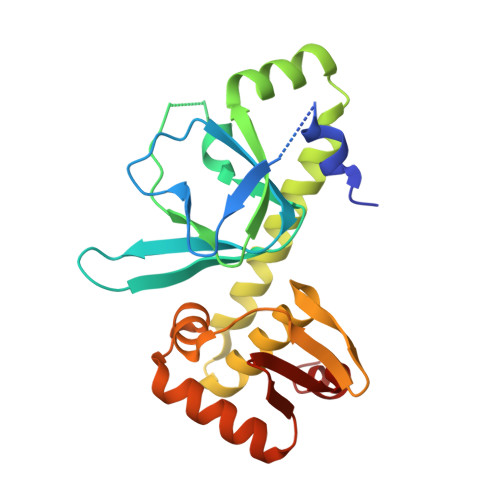Structural Basis for the Regulation of Ntca-Dependent Transcription by Proteins Pipx and Pii.
Llacer, J.L., Espinosa, J., Castells, M.A., Contreras, A., Forchhammer, K., Rubio, V.(2010) Proc Natl Acad Sci U S A 107: 15397
- PubMed: 20716687
- DOI: https://doi.org/10.1073/pnas.1007015107
- Primary Citation of Related Structures:
2XG8, 2XGX, 2XHK, 2XKO, 2XKP - PubMed Abstract:
PII, an ancient and widespread signaling protein, transduces nitrogen/carbon/energy abundance signals through interactions with target proteins. We clarify structurally how PII regulates gene expression mediated by the transcription factor NtcA, the global nitrogen regulator of cyanobacteria, shedding light on NtcA structure and function and on how NtcA is activated by 2-oxoglutarate (2OG) and coactivated by the nonenzymatic PII target, protein PipX. We determine for the cyanobacteria Synechococcus elongatus the crystal structures of the PII-PipX and PipX-NtcA complexes and of NtcA in active and inactive conformations (respective resolutions, 3.2, 2.25, 2.3, and 3.05 A). The structures and the conclusions derived from them are consistent with the results of present and prior site-directed mutagenesis and functional studies. A tudor-like domain (TLD) makes up most of the PipX structure and mediates virtually all the contacts of PipX with PII and NtcA. In the PII-PipX complex, one PII trimer sequesters the TLDs of three PipX molecules between its body and its extended T loops, preventing PipX activation of NtcA. Changes in T loop conformation triggered by 2OG explain PII-PipX dissociation when 2OG is bound. The structure of active dimeric NtcA closely resembles that of the active cAMP receptor protein (CRP). This strongly suggests that with these proteins DNA binding, transcription activation, and allosteric regulation occur by common mechanisms, although the effectors are different. The PipX-NtcA complex consists of one active NtcA dimer and two PipX monomers. PipX coactivates NtcA by stabilizing its active conformation and by possibly helping recruit RNA polymerase but not by providing extra DNA contacts.
- Instituto de Biomedicina de Valencia-Consejo Superior de Investigaciones Científicas, Centro de Investigación Biomédica en Red de Enfermedades Raras, Jaime Roig 11, Valencia 46010, Spain.
Organizational Affiliation:

















